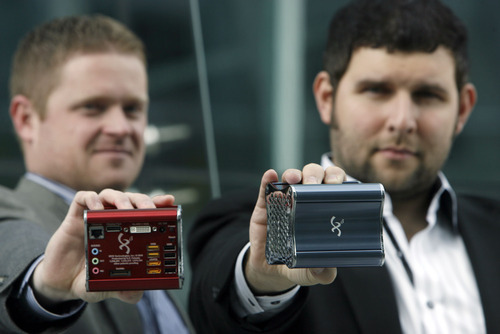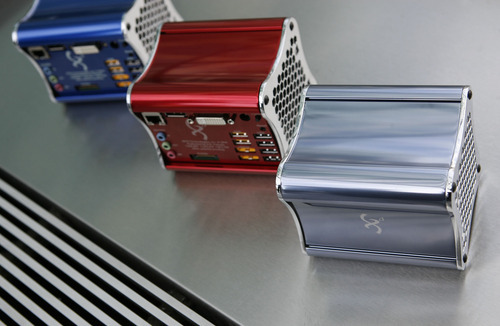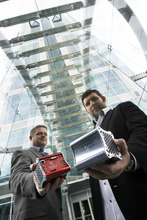This is an archived article that was published on sltrib.com in 2010, and information in the article may be outdated. It is provided only for personal research purposes and may not be reprinted.
If anything, Xi3 Inc. of Salt Lake City is highly ambitious, betting it has a big future selling a new kind of personal computer in a market dominated by the powerhouses such as Hewlett-Packard, Dell and Apple.
Founder and CEO Jason Sullivan believes he has the product to back up that ambition — an innovative, smartly designed, tiny device with the processing power of a tower but that uses a fifth of the electricity.
Although others before him have failed to gain much of a market share against the giants, the 30-something Sullivan contends "there will be a changing of the guard. There will have to be a new group of guys that bring in new ideas, who are innovating. I think that's what we've started to see. This is the birth of that next great company, of that next great idea."
Sullivan believes his bluster is backed up by a shiny, eye-catching aluminum case with no side bigger than 4 inches. It's inside, though, where the company sees its greatest edge in the market it hopes to conquer beginning early next year.
The device's novel size and its ability to be easily upgraded come from the fact that the normal motherboard has been sliced into three pieces. The main board holds the processors and memory, while a second acts as an interface between the various parts and functions.
The third card handles power, video and input and output ports for the keyboard and mouse, audio and video jacks, connections for monitors and TVs, and for the USB that connects to cameras and printers.
The third board can be smoothly changed out — eight screws hold the entire shell together — and new outputs added, such as for the next generation of USB ports or for a specialized use by a particular company. That makes the computer highly flexible and adaptable for a multitude of uses.
"Basically it's a general-use engine that can be used for any type of computing device in the world just by changing this one card," said Sullivan. "One day you may walk into a retailer and literally see 50 to 100 of these [cards] on the wall that allow you do to do specific things, maybe run an appliance, maybe the whole house."
Power saver • A second big innovation is that the Xi3 mid-level Series 5 computer uses only about 20 percent of the power of a normal computer. Through design, the company has made a device that can use as little as 5 watts of power but normally about 20 watts, compared with 110 on a tower computer. That could lead to millions of dollars of savings in electricity for a large corporation running thousands of personal computers.
The Xi3 also is designed to last 10 years instead of the norm of about three or four. No moving parts (it uses solid-state memory instead of a hard disk) and a beefed up power management system allow the company to offer a three-year warranty, Sullivan said, and when repairs are needed, the units can be easily and cheaply shipped.
The way the parts are put together also led to an increase in speed, with the tiny computer able to boot up Windows 7 Ultimate in 26 seconds.
"This is not just a new product," said Aaron Rowsell, Xi3's 33-year-old chief operating officer. "This is a whole new architecture that many different products will be built around."
Douglas Fogg, chief operating officer of Sorenson Genomics, said his company was looking for an alternative to large desktop computers and bought four of Xi3's units.
"The appeal to our organization is the compact size and low consumption of energy, particularly in a laboratory environment where counter space is premium real estate," said Fogg in an e-mail.
Sorenson Genomics did have to get one unit's power supply repaired, but Fogg said overall it found the computers "deceivingly powerful, energy efficient and surprisingly compact." His company was able to operate them on backup power after an outage shut down other machines.
Filling a niche • As for Xi3's role in the broader personal computer industry, Jim McGregor, chief technology strategist at the In-Stat research firm, said other companies such as Acer have made small computers for some time that have filled niches but not claimed a large market share.
Filling niches is where McGregor sees a place for the Xi3.
"Nothing has caught on like wildfire," he said. "The hard thing is no one has really made a huge success out of them."
Sullivan remains undaunted because he believes in the Xi3's versatility. The Series 5 model can run most every function in a normal home or office, but its design means that it can be scaled up or down to meet various needs. Its processing power and speed can be increased (at additional cost) to run high-end functions, and it can be turned into a DVR or a gaming device.
At the lower end, the company can offer a bare-bones machine with normal computing power that could greatly reduce computing costs at schools or businesses that don't have big processing power needs.
Hooking a number of the machines together could even create a supercomputer at a much lower cost than present setups, the company says.
The standard model contains 8GB of flash memory on a chip, known as solid-state storage (like that used in a digital camera), which can be upgraded to as much as 128GB. Hard drives can be attached to the outside of the shell as an accessory, but Sullivan foresees many computers using services from clouds — large banks of computers accessed over the Internet — that will allow individual computers to have far less memory than today. (Google is coming out sometime next year with an operating system that depends on cloud computing.)
Securing the patent • Beyond the innovations of the Xi3, the company has made two other big moves that distinguish it in the PC industry.
One was protecting its inventions before it set foot in the market and the other was the way it will manufacture the computers.
One reason Xi3 was founded in Salt Lake City in 2002 has to do with the former.
Sullivan grew up in Ohio, teaching himself about computers at an early age and building his first circuit board at 8, writing software at 13 and designing networks by 17, according to the company. He graduated from high school but dropped out of Youngstown State University to start his own company. The computer consulting firm proved successful, Sullivan said, but he saw that companies were paying him to fix problems that were the result of design flaws.
Wanting to build "something completely new," Sullivan said he realized he also had to protect what he invented with patents. So he searched for patent attorneys who could lock up global intellectual property rights before the product was launched this year.
"I scoured basically the Earth for the best and the brightest to write the patents, and who also were affordable," he said. "You can go to California and get an attorney for $1,200 an hour or you can get someone for a lot less."
In 2002, Sullivan started working with David Tingey of Kirton & McConkie, a Salt Lake City law firm with an intellectual property section. Tingey, who also holds a degree in electrical engineering, said the idea of having patents in hand before launching a product was unusual.
Normally, a company will launch a product with patent-pending status, meaning it has applied for protections but is waiting for issuance. Should a competitor launch a similar product, the inventing company is unable to enforce its patent rights until it actually has them in hand, he said.
ISYS Technologies Inc., the parent company that holds and will enforce the patents behind Xi3, already manages six U.S. patents and has others issued or pending in countries around the world, Tingey said.
Finding lower-priced legal help in Utah helped to greatly reduce the cost of launching the company, which was borne by Sullivan, family members and others, Sullivan said.
"What I did here with $10 million would have cost me $50 million in California," he said.
Sullivan said he also solicited individual investors to cover expenses as the company developed. The fundraising ran into a hitch in 2008 when the company could not repay a bridge loan and the lenders sued, court records show.
But the parties in the lawsuit agreed to halt court proceedings while Xi3 develops its market, with the expectation the money will be repaid, said spokesman David Politis.
Also, Xi3's COO Rowsell was the subject of several lawsuits (some still pending) involving the real estate investment company he ran when he began investing in Xi3. Politis said the legal actions resulted when Rowsell's business got caught in the economic downturn.
Made by robots • The third major business component of Xi3 is that its computer has been designed so it can be manufactured largely by robots and not require the labor-intensive processes generally required to make the devices.
Labor in China, where many computers are made, won't always be so cheap, Sullivan said, while the robotic manufacturing process the company has designed will have consistent costs. The process also means the company can have manufacturing plants on every continent where it hopes to sell computers.
The company anticipates that when the manufacturing process is perfected a computer will roll off the assembly line every six seconds.
"That is what everybody is going to be having to adapt to eventually because our costs will be cheaper," said Sullivan.
From its headquarters in downtown Salt Lake City, Xi3 has contracted with Avnet of Arizona, which buys or makes components and assembles the computers at a plant in Phoenix and also handles shipping.
Xi3 has launched its Series 5 computer into the marketplace and plans to initially concentrate on selling to the health care and education sectors.
In January, it will be a part of the huge International Consumer Electronics Show in Las Vegas, where it will show off the products that won a CES innovation award announced this year. Xi3 plans to unveil a version of the computer that will allow companies to get the cost per unit down to $350 and reduce power consumption by 95 percent from existing models. It also plans a consumer model in February, for which the cost can vary below and above the standard Series 5 model base price of $849, depending on options selected.
"We're spinning up full-flown manufacturing right now," said Rowsell, who has a finance degree from the University of Utah and was an early investor in ISYS.
Sullivan said he's convinced the computers will be successful.
"Microsoft was started 30 years ago with the idea of putting a computer in every home," Sullivan said. "This has the potential to put a computer in every room because of its size. It can be put into anything."
In the crowded market for personal computers, it's all about the idea, Sullivan said.
"Big companies need ideas to build around and all big companies were little at one point. HP started in a garage. Apple built a little computer out of a piece of wood."







